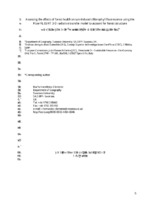Mostrar el registro sencillo del ítem
Assessing the effects of forest health on sun-induced chlorophyll fluorescence using the FluorFLIGHT 3-D radiative transfer model to account for forest structure
| dc.contributor.author | Hernández Clemente, Rocío | |
| dc.contributor.author | North, P. R. J. | |
| dc.contributor.author | Hornero, Alberto | |
| dc.contributor.author | Zarco-Tejada, Pablo J. | |
| dc.date.accessioned | 2024-02-01T07:49:43Z | |
| dc.date.available | 2024-02-01T07:49:43Z | |
| dc.date.issued | 2017 | |
| dc.identifier.issn | 1879-0704 | |
| dc.identifier.uri | http://hdl.handle.net/10396/26921 | |
| dc.description.abstract | Sun-induced fluorescence (SIF) has been proven to serve as a proxy of photosynthesis activity and therefore, as an early indicator of physiological alterations for global monitoring of vegetation. However, the interpretation of SIF over different spatial resolutions is critical to bridge the existing gap between local and global scales. This study provides insight into the influence of scene components, and forest structure and composition on the quantification of the red and far-red fluorescence signal as an early indicator of forest decline. The experiments were conducted over an oak forest (Quercus ilex) affected by water stress and Phytophthora infection in the southwest of Spain. SIF retrievals through the Fraunhofer Line Depth (FLD) principle with three spectral bands F (FLD3) was assessed using high resolution (60 cm) hyperspectral imagery extracting sunlit crown, full crown and aggregated pixels. Results showed the link between F (FLD3) extracted from sunlit crown pixels and the tree physiological condition in this context of disease infection, yielding significant relationships (r2 = 0.57, p < 0.01) for midday xylem water potential (ψ), (r2 = 0.63, p < 0.001) for the de-epoxidation state of the xanthophyll cycle (DEPS), and (r2 = 0.74, p < 0.001) for leaf-level measurements of steady-state fluorescence yield (Fs). In contrast, a poor relationship was obtained when using aggregated pixels at 30 m spatial resolution, where the relationship between the image-based F (FLD3) and Fs yielded a non-significant relationship (r2 = 0.25, p > 0.05). These results demonstrate the need for methods to accurately retrieve crown SIF from aggregated pixels in heterogeneous forest canopies with large physiological variability among individual trees. This aspect is critical where structural canopy variations and the direct influence of background and shadows affect the SIF amplitude masking the natural variations caused by physiological condition. FluorFLIGHT, a modified version of the three dimensional (3-D) radiative transfer model FLIGHT was developed for this work, enabling the simulation of canopy radiance and reflectance including fluorescence at different spatial resolutions, such as may be derived from proposed satellite missions such as FLEX, and accounting for canopy structure and varying percentage cover. The 3-D modelling approach proposed here significantly improved the relationship between Fs and F (FLD3) extracted from aggregated pixels (r2 = 0.70, p < 0.001), performing better than when aggregation effects were not considered (r2 = 0.42, p < 0.01). The FluorFLIGHT model used in this study improved the retrieval of SIF from aggregated pixels as a function of fractional cover, Leaf Area Index and chlorophyll content yielding significant relationships between Fs ground-data measurements and fluorescence quantum yield estimated with FluorFLIGHT at p < 0.01 (r2 = 0.79). The methodology presented here using FluorFLIGHT also demonstrated its capabilities for mapping SIF at the tree level for single tree assessment of forest physiological condition in the context of early disease detection. | es_ES |
| dc.format.mimetype | application/pdf | es_ES |
| dc.language.iso | eng | es_ES |
| dc.publisher | Science Direct | es_ES |
| dc.rights | https://creativecommons.org/licenses/by-nc-nd/4.0/ | es_ES |
| dc.source | Remote Sensing of Environment, Vol. 193, Pages 165-179 (2017) | es_ES |
| dc.subject | Fluorescence | es_ES |
| dc.subject | Stress detection | es_ES |
| dc.subject | Hyperspectral | es_ES |
| dc.subject | SIF | es_ES |
| dc.subject | RTM | es_ES |
| dc.subject | Forest dieback | es_ES |
| dc.subject | Oak forest | es_ES |
| dc.subject | Phytophthora infection | es_ES |
| dc.title | Assessing the effects of forest health on sun-induced chlorophyll fluorescence using the FluorFLIGHT 3-D radiative transfer model to account for forest structure | es_ES |
| dc.type | info:eu-repo/semantics/article | es_ES |
| dc.relation.publisherversion | https://doi.org/10.1016/j.rse.2017.02.012 | es_ES |
| dc.relation.projectID | Gobierno de España. THERMOLIDAR FP7 | es_ES |
| dc.relation.projectID | Gobierno de España. QUERCUSAT | es_ES |
| dc.rights.accessRights | info:eu-repo/semantics/openAccess | es_ES |

